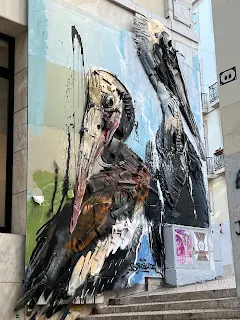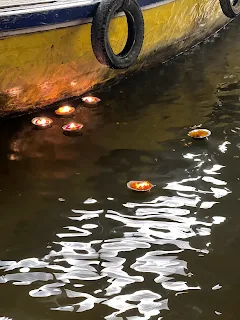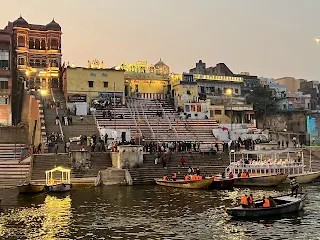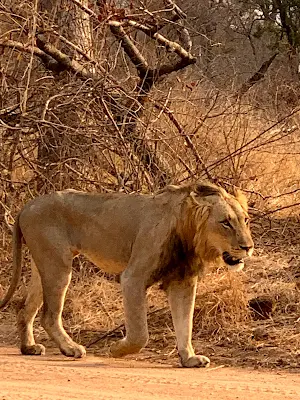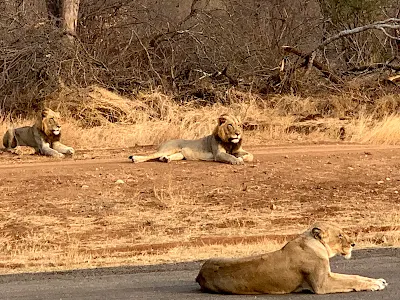The main historical neighborhoods inn Portugal include Chiado, Bairro Alto, Alfama and Belem. In general, most areas within the central/historical Lisbon are walkable but easier to go uphill in a vehicle and come down on your own two feet. We uber’ed when going uphill (or longer distances such as Belem).
Chiado is a very central neighborhood, upscale, happening, close to good restaurants and lively. We rented an apartment here and made this neighborhood our base. Every couple of blocks there was a square. In the evenings these squares came alive with families, kids, music and food. These squares are where we spent majority of our spare time, just being a part of the city, a part of the tourist crowd people watching.
Assuming that you reach Lisbon in the morning and spend the morning portion of your day settling in. Spend the remainder of your afternoon exploring Chiado and Baixa-Chiado. Walk from Rossio train station to Baixa-Chiado metro stop stopping by way of Largo Camoes square. From there to the Elevator S Justa. We chose not to go up the elevators.. for one there was a long line and another we plan to see the city from the castle. Btw.. did you notice the two pelicans?
From the Elevator walk on to Praca de Comercio, walk along the touristy Rua do Ouro or one of the parallel streets. All the way to the arch and to the beach. Trace your way back along the tram 28 tracks. Marvel at the tiled buildings, the gorgeous pink flower trees, the music and the tinned Sardine stores.
 |
| Grilled Octopus |
 |
Torre de Belém |
 |
Mosteiro dos Jerónimos |
 |
Mosteiro dos Jerónimos |
After lunch, we came back to the apartment in Chiado for a short nap and rest.
 |
| Lisbon Cathedral |
For the second half of the day, we walked to the Cathedral. From the Cathedral there are a few choices- walk uphill, or take the scenic tram 28 going in the uphill direction (if you have a full day pass, you can use the tram to hop on hop off.. we did not buy the day passes, choosing to either walk or Uber in the interest of time and to avoid the crowds) or take a tuk-tuk (1hr tour for 2 ppl for 70 Euro and the driver comes disguised a guide). We did the Tuk Tuk tour, stopping at 4-5 stops along the way. After the tuk-tuk tour, we leisurely walked back to Chiado area.
 This day we dined at O Portugues (https://o-portugues-chiado.negocio.site/), Chiado, Rua dos Duques de Braganca, 5G Chiado, Lisboa. The restaurant was upscale and some of the best food we had in Lisbon with live music. We asked the singer to sing some Fado music.. not his speciality but he obliged and sang a happy fado and a sad fado. Both awesome renditions. Every dish that we tried was really well prepared, the Vegan dumplings, grilled octopus, cod coquettes, and so much more. This restaurant requires reservations so plan in advance. After dinner, I am sure you will need a long walk back to the apartment hopefully along a way that takes you past a lively square, perhaps the one near the Baixa-Chiado metro.
This day we dined at O Portugues (https://o-portugues-chiado.negocio.site/), Chiado, Rua dos Duques de Braganca, 5G Chiado, Lisboa. The restaurant was upscale and some of the best food we had in Lisbon with live music. We asked the singer to sing some Fado music.. not his speciality but he obliged and sang a happy fado and a sad fado. Both awesome renditions. Every dish that we tried was really well prepared, the Vegan dumplings, grilled octopus, cod coquettes, and so much more. This restaurant requires reservations so plan in advance. After dinner, I am sure you will need a long walk back to the apartment hopefully along a way that takes you past a lively square, perhaps the one near the Baixa-Chiado metro.
The next 1/2 day for us was a trip to the Castle. Entry into the castle grounds requires a
ticket which is not included in the Lisboa card. You can take the tram or Uber. We went the Uber route. We spent about 2 hours just strolling in the castle. Nice views of the city from every angle. Other than great views there is not much to see. They do have a small museum in the castly. From the castly, we walked back.. an easy downhill walk, strolling through the Alfama neighborhood. We stopped to grab lunch in Grasa. Grasa neighborhood overlooked Alfama, a great view but food here was nothing special. For dinner, we dined at a restaurant in Alfama.
 |
| Graca |
There were 2-3 restaurants in Alfama, in a square opposite the Fado museum. A Couple of ladies selling Ginjinha in a chocolate cup.. a local cherry wine. Worth a tasting. Dined at one of the places near the square as we listened to live Fado music. The singers generally come around 8 pm and the restaurants open for dinner around 7:30 ish.
If you have time, walk from where ever you are (Praca de Comercio/Chaido) to Timeoff market. Breakfast/lunch at Timeoff market. On Tuesdays - Sundays, there is a fresh fruit and vegetable market right in that building.
Rest of the time we spent exploring the historical neighborhoods. It is easier to explore when you break up the day into 1/2 days.. in between the transitions, we either came back to the apartment to rest and freshen up or at a square just absorbing the vibe.
 |
| Pink Street |
 |
| Cod fish croquettes |
